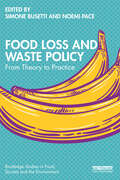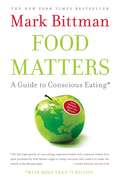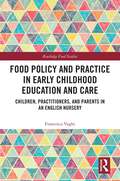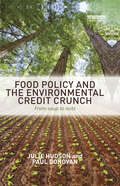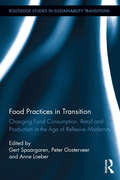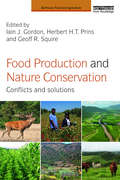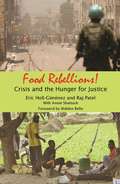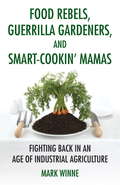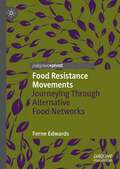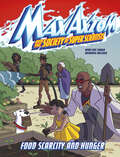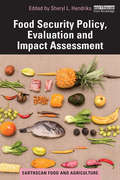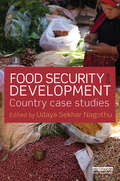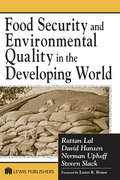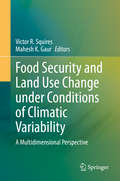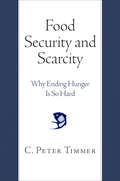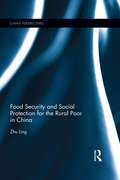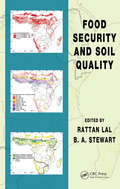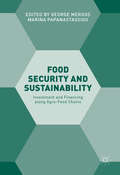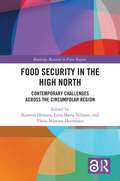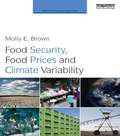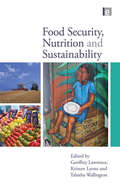- Table View
- List View
Food Loss and Waste Policy: From Theory to Practice (Routledge Studies in Food, Society and the Environment)
by Simone Busetti Noemi PaceThis book examines policy responses to food waste and loss, an issue of significant, global concern, with one-third of food produced for human consumption lost or wasted. Investigating food waste and loss under an interdisciplinary lens, the contributors employ a variety of methodological approaches, including quantitative and qualitative techniques, drawing on in-depth case studies and action research. The volume is organised into four parts: Understanding Food Loss and Waste, International Programmes, National Policies and Local Initiatives. The first part introduces the reader to the concept of food loss and waste, how it can be measured, its causes and consequences, and how it can be reduced. The second part is dedicated to international and cross-country case studies, with six chapters reviewing national policies implemented in France, Italy, Romania, Japan, China and the United States. In Part Four, three chapters are dedicated to local food recovery and redistribution initiatives. By focusing on different territories and different levels of governance, the book provides a detailed evaluation of food loss and waste policies, the barriers and opportunities of implementing the policies, as well as the impact they are actually having. The chapters are both descriptive and evaluative and draw out lessons for designing, implementing and reforming programmes. This book will be of great interest to students and scholars working on food waste, food policy, sustainable food systems, agricultural production and supply chains and public policy, as well as policymakers involved with developing and implementing programmes and policies to regulate and reduce food waste and loss.
Food Marketing and Selling Healthy Lifestyles with Science: Transhistorical Perspectives (Critical Food Studies)
by Lauren Alex O'Hagan Göran ErikssonThis book sets out to historicise our understanding of contemporary trends by studying the long relationship between science, food and drink marketing and the promotion of healthy lifestyles. It aims to bring together contemporary and historical research from a multimodal perspective, considering how scientific discourse and ideas about health and nutrition are channelled through visual and material culture.Using examples of advertisements, commercials and posters, the 16 chapters in this book will foster a cross-disciplinary and cross-temporal dialogue, uncovering links between past and present ways that manufacturers have capitalised upon scientific innovations to create new products or rebrand existing products and employed science to make claims about health and nutrition. They will, thus, demonstrate the continuity of science in food and drink marketing—even if fundamental ideas of nutrition have evolved over time. The book provides crucial new insights into the significance of the late nineteenth and early twentieth centuries as a period of innovation in food and drink marketing and showcasing how many of the marketing strategies employed today, in fact, have a far broader historical trajectory.It will be of great interest to students and scholars of Critical Food Studies, Media and Communication Studies, History of Science and Medicine and Cultural Studies, as well as nutritionists, dieticians, sportspeople, in addition to policymakers and practitioners working in the area of food and drink marketing.
Food Matters: A Guide to Conscious Eating with More Than 75 Recipes
by Mark BittmanFrom the award-winning champion of culinary simplicity who gave us the bestselling How to Cook Everything and How to Cook Everything Vegetarian comes Food Matters, a plan for responsible eating that's as good for the planet as it is for your weight and your health. We are finally starting to acknowledge the threat carbon emissions pose to our ozone layer, but few people have focused on the extent to which our consumption of meat contributes to global warming. Think about it this way: In terms of energy consumption, serving a typical family-of-four steak dinner is the rough equivalent of driving around in an SUV for three hours while leaving all the lights on at home. Bittman offers a no-nonsense rundown on how government policy, big business marketing, and global economics influence what we choose to put on the table each evening. He demystifies buzzwords like "organic," "sustainable," and "local" and offers straightforward, budget-conscious advice that will help you make small changes that will shrink your carbon footprint -- and your waistline. Flexible, simple, and non-doctrinaire, the plan is based on hard science but gives you plenty of leeway to tailor your food choices to your lifestyle, schedule, and level of commitment. Bittman, a food writer who loves to eat and eats out frequently, lost thirty-five pounds and saw marked improvement in his blood levels by simply cutting meat and processed foods out of two of his three daily meals. But the simple truth, as he points out, is that as long as you eat more vegetables and whole grains, the result will be better health for you and for the world in which we live. Unlike most things that are virtuous and healthful, Bittman's plan doesn't involve sacrifice. From Spinach and Sweet Potato Salad with Warm Bacon Dressing to Breakfast Bread Pudding, the recipes in Food Matters are flavorful and sophisticated. A month's worth of meal plans shows you how Bittman chooses to eat and offers proof of how satisfying a mindful and responsible diet can be. Cheaper, healthier, and socially sound, Food Matters represents the future of American eating.
Food Policy and Practice in Early Childhood Education and Care: Children, Practitioners, and Parents in an English Nursery (Routledge Food Studies)
by Francesca VaghiThis book is about food and feeding in early childhood education and care, offering an exploration of the intersection of children’s food, education, family intervention, and public health policies. The notion of ‘good’ food for children is often communicated as a matter of common sense by policymakers and public health authorities; yet the social, material, and practical aspects of feeding children are far from straightforward. Drawing on a detailed ethnographic study conducted in a London nursery and children’s centre, this book provides a close examination of the practices of childcare practitioners, children, and parents, asking how the universalism of policy and bureaucracy fits with the particularism of feeding and eating in the early years. Looking at the unintended consequences that emerged in the field, such as contradictory public health messaging and arbitrary policy interventions, the book reveals the harmful assumptions about disadvantaged groups that are perpetuated in policy discourse, and challenges the constructs of individual choice and responsibility as main determinants of health. Children’s food practices at the nursery are examined to explore the notion that, whilst for adults it is what children eat that often matters most, to children it is how they eat that is more important. This book contributes to a growing body of literature evidencing how children’s food is a contested domain, in which power relations are continuously negotiated. This raises questions not only on how children can be included in policy beyond a tokenistic involvement but also on what children’s well-being might mean beyond the biomedical sphere. The book will particularly appeal to students and scholars in food and health, food policy, childhood studies, and medical anthropology. Policymakers and non-governmental bodies working in the domains of children’s food and early years policies will also find this book of interest.
Food Policy and the Environmental Credit Crunch: From Soup to Nuts
by Paul Donovan Julie HudsonThe changing economic environment for the consumer that is emerging from the wreckage of the financial credit crunch plays directly into the importance of food spending. This is certainly true from the perspective of food prices in the short run, but also from the perspective of sustainability and reducing the impact of the environmental credit crunch. The economic changes we experience now have a bearing on our ability to manage the environmental credit crunch that looms. Food Policy and the Environmental Credit Crunch: From Soup to Nuts elaborates on the issues addressed in the authors’ first book, From Red to Green?,and asks whether the financial credit crunch could ameliorate or exacerbate the emergent environmental credit crunch. The conclusion drawn here is that a significant and positive difference could be made by changing some of the ways in which we procure, prepare, and consume our food. Written by an economist and an investment professional, this book addresses the economic and environmental implications of how we treat food. The book examines each aspect of the ‘food chain’, from agriculture, to production and processing, retail, preparation, consumption and waste.
Food Policy in the United Kingdom: An Introduction (Earthscan Food and Agriculture)
by Rebecca Wells Martin Caraher Sinéad FureyThis book provides an introduction to food policy in the United Kingdom, examining policy development, implementation, influences and current issues. The book begins by providing a wide-ranging introduction to food policy in the UK, situating it within wider global debates and establishing key drivers, such as issues related to global citizenship, trade and finance. The use of food control as a policy lever is also discussed and contrasted with alternative approaches based on behaviour change. The book presents an overview of the history of UK food policy, from which there is much to be learned, before moving onto current challenges posed by political instability, both at home and abroad, global pandemics and cost of living crises. Foremost is the need to manage public health, including both malnutrition and obesity, while promoting sustainable and healthy diets, as well as the broader issues around addressing food security and food poverty. The book also examines public sector food initiatives, such as school food and early childhood provisions, and food regulation. As a part of food regulation, chapters examine food scares and food fraud, from chalk in flour to "horsegate". The role of media, marketing and advertising is also considered within a policy perspective. Taking a wider lens, the book also discusses the impact of global food trade and the financialisation of food on food policy in the UK and vice versa. The book is supported by instructor eResources on the Routledge website designed to support student learning as well as provide regular updates on UK food policy developments. The eResources include student activities, group exercises and links to further reading and additional resources. This book serves as a key introduction to UK food and agricultural policy for students, scholars, policymakers and professionals, as well as those interested in food systems, public health and social policy more widely.
Food Policy in the United States: An Introduction (Earthscan Food and Agriculture)
by Parke WildeThis third edition of Food Policy in the United States offers a timely update to the leading textbook dedicated to all aspects of food policy in the United States.This book begins with the economic interests of farmers and food producers and then moves on to examine nutrition policy, food justice, food security, and the environment. Finding motivation in real-world controversies and debates, chapters cover domestic agriculture, international agricultural trade, food and beverage manufacturing, food retail and restaurants, food safety, dietary guidance, food labeling, advertising, and federal food assistance programs for the poor. Building on the success of the second edition, which received the Distinguished Quality of Communication award from the Agricultural and Applied Economics Association (AAEA), this new edition has been revised and updated, offering greater attention both to food justice issues, and to economic methods. It covers policy changes since the 2018 Farm Bill, the publication of the 2020–2025 Dietary Guidelines for Americans, the 2021 update to the "Thrifty Food Plan", and President Donald Trump's approach to food and agricultural trade. The impact of COVID-19 and the continuing climate crisis are examined, alongside stalled child nutrition reauthorization legislation, reforms in food-labeling, and immigration policy. The online Instructor and Student Resources include supplemental economic appendices, problem sets, activities, and exercises: www.routledge.com/cw/Wilde. This book makes U.S. food policy more comprehensible to those inside and outside the agri-food sector whose interests and aspirations have been ignored.This book is essential reading for all students, researchers, and policymakers seeking to understand U.S. food policy from a wide range of interdisciplinary backgrounds, including food studies, agricultural and food economics and policy, public health and nutrition, and public policy.
Food Practices and Family Lives in Urban China
by Chen LiuThis book explores the emergent relationship between food and family in contemporary China through an empirical case study of Guangzhou, a typical city, to understand the texture of everyday life in the new consumerist society. The primary focus of this book is on the family dynamics of middle-income households in Guangzhou, where everyday food practices, including growing food, shopping, storing, cooking, feeding, and eating, play a pivotal role. The book aims to conduct a comprehensive and integrated analysis of themes such as material and emotional domestic cultures, family relationships, and social connections between the domestic and the public, based on a discussion of family food practices. These topics will not only offer academic readers a full understanding of the most innovative recent critical engagements with urban Chinese families but also provide more general readers with a broader view of food consumption patterns within the scope of domestic and family issues. This book will be of interest to sociologists, anthropologists, and human geographers as well as post graduate students who are interested in food studies and Chinese studies.
Food Practices in Transition: Changing Food Consumption, Retail and Production in the Age of Reflexive Modernity (Routledge Studies in Sustainability Transitions)
by Gert Spaargaren Peter Oosterveer Anne LoeberThis edited volume presents and reflects upon empirical evidence of ‘sustainability’-induced and -related transition in food practices. The material collected in the various chapters contributes to our understanding of the ways in which ideas and preferences, sociotechnological developments and changes in the governance of food interact and become visible in practices of consumption, retail and production.
Food Production and Nature Conservation: Conflicts and Solutions (Earthscan Food and Agriculture)
by Iain J. Gordon Herbert H.T. Prins Geoff R. SquireFeeding the world's growing human population is increasingly challenging, especially as more people adopt a western diet and lifestyle. Doing so without causing damage to nature poses an even greater challenge. This book argues that in order to create a sustainable food supply whilst conserving nature, agriculture and nature must be reconnected and approached together. The authors demonstrate that while the links between nature and food production have, to some extent, already been recognized, until now the focus has been to protect one from the impacts of the other. Instead, it is argued that nature and agriculture can, and should, work together and ultimately benefit from one another. Chapters describe efforts to protect nature through globally connected protected area systems and illustrate how farming methods are being shaped to protect nature within agricultural systems. The authors also point to many ways in which nature benefits agriculture through the ecosystem services it provides. Overall, the book shows that nature conservation and food production must be considered as equally important components of future solutions to meet the global demand for food in a manner that is sustainable for both the human population and the planet as a whole.
Food Rebellions
by Raj Patel Eric Holt-GimenezToday there are over a billion hungry people on the planet, more than ever before in history. While the global food crisis dropped out of the news in 2008, it returned in 2011 (and is threatening us again in 2012) and remains a painful reality for the world's poor and underserved. Why, in a time of record harvests, are a record number of people going hungry? And why are a handful of corporations making record profits? In Food Rebellions! Crisis and the Hunger for Justice, authors Eric Holt-Giménez and Raj Patel with Annie Shattuck offer us the real story behind the global food crisis and document the growing trend of grassroots solutions to hunger spreading around the world.Food Rebellions! contains up to date information about the current political and economic realities of our food systems. Anchored in political economy and an historical perspective, it is a valuable academic resource for understanding the root causes of hunger, growing inequality, the industrial agri-foods complex, and political unrest. Using a multidisciplinary approach, Holt-Giménez and Patel give a detailed historical analysis of the events that led to the global food crisis and document the grassroots initiatives of social movements working to forge food sovereignty around the world. These social movements and this inspiring book compel readers to confront the crucial question: Who is hungry, why, and what can we do about it?
Food Rebels, Guerrilla Gardeners, and Smart-Cookin' Mamas
by Mark WinneIn an age of uncertainty about how climate change may affect the global food supply, industrial agribusiness promises to keep the world fed. Through the use of factory "farms," genetic engineering, and the widespread application of chemicals, they put their trust in technology and ask consumers to put our trust in them. However, a look behind the curtain reveals practices that put our soil, water, and health at risk. What are the alternatives? And can they too feed the world? The rapidly growing alternative food system is made up of people reclaiming their connections to their food and their health. A forty-year veteran of this movement, Mark Winne introduces us to innovative "local doers" leading the charge to bring nutritious, sustainable, and affordable food to all. Heeding Emerson's call to embrace that great American virtue of self-reliance, these leaders in communities all across the country are defying the authority of the food conglomerates and taking matters into their own hands. They are turning urban wastelands into farms, creating local dairy collectives, preserving farmland, and refusing to use genetically modified seed. They are not only bringing food education to children in elementary schools, but also offering cooking classes to adults in diabetes-prone neighborhoods--and taking the message to college campuses as well. Such efforts promote food democracy and empower communities to create local food-policy councils, build a neighborhood grocery store in the midst of a food desert, or demand healthier school lunches for their kids. Winne's hope is that all of these programs, scaled up and adopted more widely, will ultimately allow the alternative food system to dethrone the industrial. Food Rebels, Guerrilla Gardeners, and Smart-Cookin' Mamas challenges us to go beyond eating local to become part of a larger solution, demanding a system that sustains body and soul.
Food Resistance Movements: Journeying Through Alternative Food Networks (Alternatives and Futures: Cultures, Practices, Activism and Utopias)
by Ferne EdwardsThis book examines food resistance movements as a form of alternative food network, charting the author’s journey as a cultural anthropologist through three food resistance movements.In Australia, freegans’ consumption of ‘garbage’ in the food waste movement of the early 2000s reveals the extent of food going to waste from commercial sources while people go hungry. In contrast, Venezuela’s food sovereignty movement is part of a national transition from a capitalist to socialist economy, highlighting processes of decentralisation, collectivisation, and government-grassroots’ coalitions. The study of autonomous spaces in Catalonia illuminates how food sharing can enable people to live their politics, as well as the centrality of issues around urban governance, consumption, technology and use of space to food resistance efforts. This engaging volume brings an important and engaging contribution to current discussions around the transition to just and sustainable food systems.
Food Scarcity and Hunger: A Max Axiom Super Scientist Adventure (Max Axiom and the Society of Super Scientists)
by Myra Faye TurnerEvery year, the world’s farmers produce a lot of food for people to eat. Yet every night, millions of people around the world go to bed hungry. Why are people going without food when the earth is able to produce so much? In this nonfiction graphic novel, Max Axiom and the Society of Super Scientists go on a fact-finding mission to discover the reasons behind food scarcity. Young readers can join the team to find out why many people deal with food insecurity and learn ways that they can help.
Food Security Policy, Evaluation and Impact Assessment (Earthscan Food and Agriculture)
by Sheryl. L. HendriksThis book offers an essential, comprehensive, yet accessible reference of contemporary food security discourse and guides readers through the steps required for food security analysis. Food insecurity is a major obstacle to development and achievement of the Sustainable Development Goals. It is a complex issue that cuts across traditional sectors in government and disciplines in academia. Understanding how multiple elements cause and influence food security is essential for policymakers, practitioners and scholars. This book demonstrates how evaluation can integrate the four elements of food security (availability, access, nutrition and resilience) and offers practical tools for policy and programme impact assessment to support evidence-based planning. Aimed at researchers, postgraduates and those undertaking professional development in food studies, agricultural economics, rural development, nutrition and public health, the book is key reading for those seeking to understand evidence-based food security analysis.
Food Security and Development: Country Case Studies
by Udaya Sekhar NagothuThe global food system is characterized by large numbers of people experiencing food insecurity and hunger on the one hand, and vast amounts of food waste and overconsumption on the other. This book brings together experiences from different countries addressing the challenges associated with food security. Seen through various disciplinary lenses the different cases included are countries at various stages of food security, with diverse stories of success as well as failures in their efforts. China, Brazil and India, as well as less developed countries in Africa and Asia, such as Malawi, Ethiopia, Tanzania, Myanmar, Bangladesh and the Philippines. The authors pay special attention to the environmental and socio-economic challenges in the respective chapters and how they contribute to food insecurity. Each of the case studies identifies and analyzes which factors or drivers (environmental, economic, policy, technology, markets) have been the most powerful shapers of the food system and their future impact. The case studies identify interventions at regional, national and local level that contribute positively to food security, highlighting solutions that are effective and easy to implement for all levels of decision makers, from farmers to policy makers. Overall, the book provides insights in order to foster a greater understanding of the issues surrounding food security and support progress towards the goal of a sustainable food system for all.
Food Security and Environmental Quality in the Developing World
by David Hansen Rattan Lal Norman Uphoff Steven SlackCan developing countries meet the food requirements of their growing populations without jeopardizing a natural resource base that is already under great stress?Can increases in food production achieved in the past two decades be sustained in the next two decades?Can developing countries achieve freedom from hunger and malnutrition
Food Security and Land Use Change under Conditions of Climatic Variability: A Multidimensional Perspective
by Victor R. Squires Mahesh K. GaurThis volume analyzes the global challenges of food security, land use changes, and climate change impacts on food production in order to recommend sustainable development policies, anticipate future food services and demands, and identify the economic benefits and trade-offs of meeting food security demands and achieving climate change mitigation objectives. The key points of analysis that form the conclusions of this book are based on measuring the quantity and quality of land and water resources, and the rate of use of sustainable management of these resources in the context of socio-economic factors, including food security, poverty, and climate change impacts. In six parts, readers will learn about these crucial dimensions of the affects of climate change on food security, and will gain a better understanding of how to assess the trade-offs when combating multiple climate change challenges and how to develop sustainable solutions to these problems. The book presents multidimensional perspectives from expert contributors, offering holistic and strategic approaches to link knowledge on climate change and food security with action in the form of policy recommendations, with a focus on sociological and socio-economic components of climate change impacts. The intended audience of the book includes students and researchers engaged in climate change and food security issues, NGOs, and policy makers.
Food Security and Scarcity: Why Ending Hunger Is So Hard
by C. Peter TimmerIn countries that have managed to confront and cope with the challenges of food insecurity over the past two centuries, markets have done the heavy lifting. Markets serve as the arena for allocating society's scarce resources to meet the virtually unlimited needs and desires of consumers: no other mechanism can efficiently signal fluctuations in scarcity and abundance, the cost of labor, or the value of commodities. But markets fail at tasks that society regards as important; thus, governments have had to intervene to stabilize the economic environment and provide essential public goods, such as transportation and communications networks, agricultural research and development, and access to quality health and educational facilities. Ending hunger requires that each society find the right balance of market forces and government interventions to drive a process of economic growth that reaches the poor and ensures that food supplies are readily, and reliably, available and accessible to even the poorest households. But locating that balance has been a major challenge for many countries, and seems to be getting more difficult as the global economy becomes more integrated and less stable.Food Security and Scarcity explains what forms those challenges take in the long run and short term and at global, national, and household levels. C. Peter Timmer, best known for his work on the definitive text Food Policy Analysis, draws on decades of food security research and analysis to produce the most comprehensive and up-to-date assessment of what makes a productive, sustainable, and stable food system—and why so many countries have fallen short. Poverty and hunger are different in every country, so the manner of coping with the challenges of ending hunger and keeping it at bay will depend on equally country-specific analysis, governance, and solutions. Timmer shows that for all their problems and failures, markets and food prices are ultimately central to solving the problem of hunger, and that any coherent strategy to improve food security will depend on an in-depth understanding of how food markets operate.Published in association with the Center for Global Development.
Food Security and Social Protection for the Rural Poor in China (China Perspectives)
by Ling ZhuEconomic growth and its relevant subjects have been given the first priority in the research agenda since China initiated economic reforms in 1978, while the topics of social protection and gender equality have been largely left at the periphery for a long period. This book is a collection of evidence-based studies conducted mainly in poor areas of rural China during the recent two decades. Based on individual interviews and sample data analyses, this book emphasizes the importance of cooperative organizations to poverty reduction, and puts forward that gender equality is closely related with sustainable development. In addition, it addresses the issues of food security and elimination of social exclusion - the key to bridging economic divide. It also studies social protection, including basic health protection system, nutrition and healthcare for children, old age security for landless farmers and rural migrant workers. By providing first-hand accounts of different vulnerable groups, such as the poor, women, migrant workers, ethnic minorities and small farmers, this book offers valuable insights into studies of contemporary Chinese society and economy.
Food Security and Soil Quality (Advances in Soil Science)
by Paul C. H. LiJust five years ago, it was generally believed that the number of food insecure people in the world was on continuous decline. Unfortunately, widespread soil degradation along with resistance to recommended agronomic practices, and little attempt to restore degraded soils have conspired with significant droughts (in regions that could least tolerat
Food Security and Sustainability: Investment and Financing along Agro-Food Chains
by George Mergos and Marina PapanastassiouThis edited volume brings together contributions from experts on a range of food security issues, and examines them through a number of case studies. A Millennium Development goal and important policy concern, food security is experiencing renewed interest due to globalisation, which has led to population affluence, changing consumption, and production and trade patterns. The authors discuss how globalisation brings a new dimension to the discussion on public policy on food security, and consider the extent to which Global Value Chains (GVCs) dominate trade, investment and international agricultural markets. Food Security and Sustainability therefore sheds new light on the nexus of food security and globalization, as well as its implications for investment and financing in the agro-food sector. The volume draws on papers presented at the inaugural Workshop of the Mediterranean Center for Food Security and Sustainable Growth (MED-SEC), an international network of academics focusing on issues of development, sustainability and food security.
Food Security in the High North: Contemporary Challenges Across the Circumpolar Region (Routledge Research in Polar Regions)
by Thora Martina Herrmann Kamrul Hossain Lena Maria NilssonThis book explores the challenges facing food security, sustainability, sovereignty, and supply chains in the Arctic, with a specific focus on Indigenous Peoples. Offering multidisciplinary insights with a particular focus on populations in the European High North region, the book highlights the importance of accessible and sustainable traditional foods for the dietary needs of local and Indigenous Peoples. It focuses on foods and natural products that are unique to this region and considers how they play a significant role towards food security and sovereignty. The book captures the tremendous complexity facing populations here as they strive to maintain sustainable food systems – both subsistent and commercial – and regain sovereignty over traditional food production policies. A range of issues are explored from food contamination risks, due to increasing human activities in the region, such as mining, to changing livelihoods and gender roles in the maintenance of traditional food security and sovereignty. The book also considers processing methods that combine indigenous and traditional knowledge to convert the traditional foods, which are harvested or hunted, into local foods. This book offers a broader understanding of food security and sovereignty, and will be of interest to academics, scholars, and policy makers working in food studies, geography and environmental studies, agricultural studies, sociology, anthropology, political science, health studies, and biology.
Food Security, Food Prices and Climate Variability (Earthscan Food and Agriculture)
by Molly E. BrownThe agriculture system is under pressure to increase production every year as global population expands and more people move from a diet mostly made up of grains, to one with more meat, dairy and processed foods. This book uses a decade of primary research to examine how weather and climate, as measured by variations in the growing season using satellite remote sensing, has affected agricultural production, food prices and access to food in food-insecure regions of the world. The author reviews environmental, economics and multidisciplinary research to describe the connection between global environmental change, changing weather conditions and local staple food price variability. The context of the analysis is the humanitarian aid community, using the guidance of the USAID Famine Early Warning Systems Network and the United Nation’s World Food Program in their response to food security crises. These organizations have worked over the past three decades to provide baseline information on food production through satellite remote sensing data and agricultural yield models, as well as assessments of food access through a food price database. These datasets are used to describe the connection, and to demonstrate the importance of these metrics in overall outcomes in food-insecure communities.
Food Security, Nutrition and Sustainability
by Geoffrey Lawrence Kristen Lyons Tabatha WallingtonAs the threats of food insecurity loom ever larger, the world faces the sad irony of food shortages in the global South alongside a purported 'obesity epidemic' in the global North. The twin issues of food production and food access are of particular concern in the context of climate change, 'peak oil', biofuels, and land grabs by wealthy nations. Food Security, Nutrition and Sustainability offers critical insights by international scholars, with chapters on global food security, supermarket power, new technologies, and sustainability. The book also assesses the contributions of diet and nutrition research in building socially just and environmentally sustainable food systems and provides policy recommendations to improve the health and environmental status of contemporary agri-food systems. The book features contributions from a range of social science perspectives, including sociology, anthropology, public health and geography, with case study material drawn from throughout the world.
